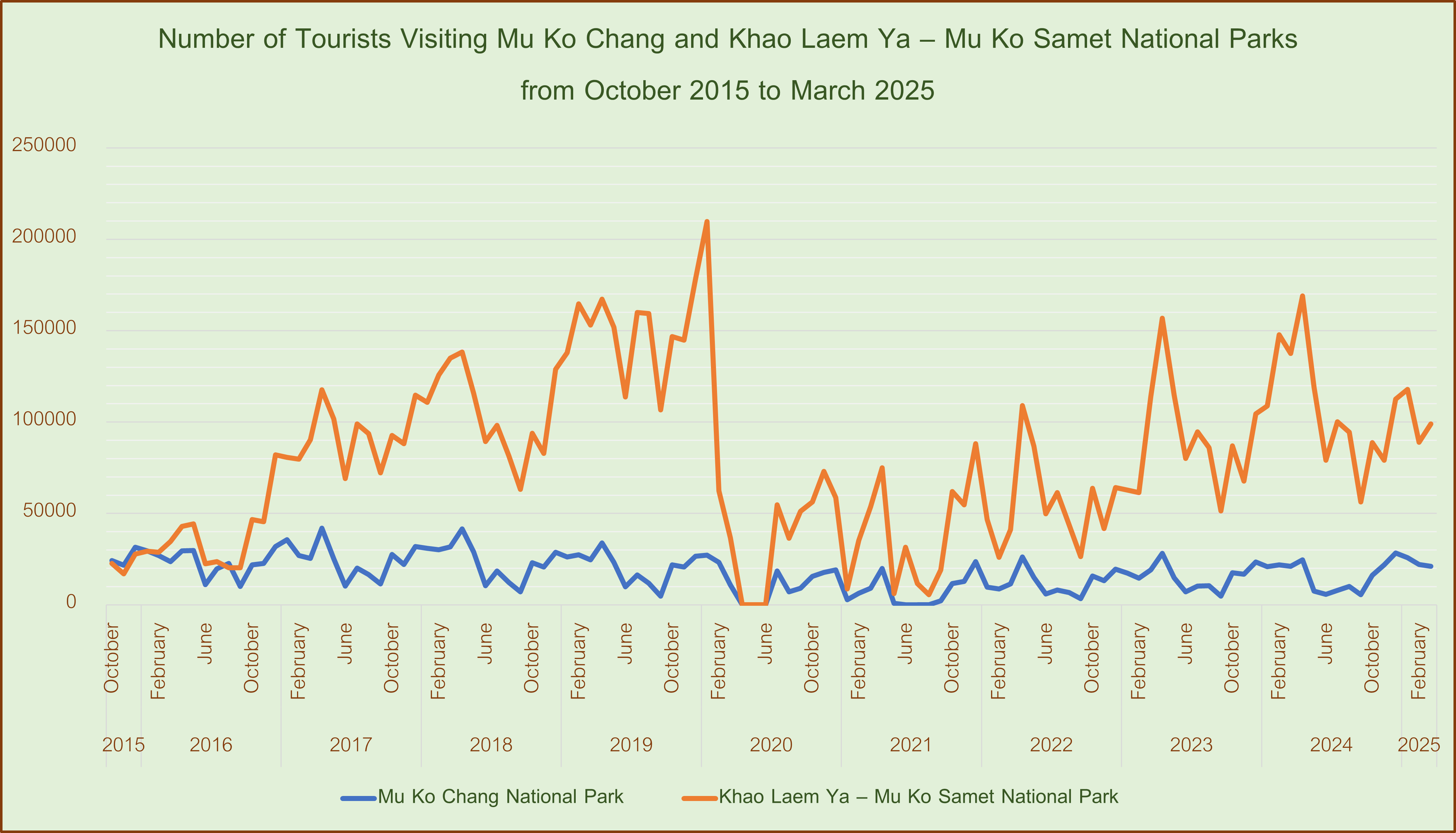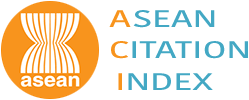Forecasting the Number of Tourists and Managing Interrupted Time Series Data for Sustainable Tourism Development in Thailand's Eastern Marine National Parks
Keywords:
missing value imputation, COVID-19 pandemic, time series data, seasonal decomposition, forecasting modelAbstract
Background and Objectives : Thailand is internationally recognized as one of the world's major tourist destinations. Tourism also plays an important role in driving the country's economic growth. The tourism industry is not only a primary source of national revenue, but also a key mechanism for promoting employment and overall economic development. However, the outbreak of COVID-19 in late 2019 significantly affected the domestic tourism industry due to the implementation of strict public health measures, such as lockdowns and travel restrictions. As a result, no international tourists have entered Thailand since April 2020. Additionally, important popular marine tourist attractions in the eastern region, including Mu Ko Chang National Park and Khao Laem Ya – Mu Ko Samet National Park, were affected by the closure of tourism in national parks and forest parks. After the country reopened in late 2021, the tourism industry began to recover, resulting in a noticeable increase in visitors to these two eastern marine national parks. Thus, accurate forecasting of tourist numbers is important for helping related agencies manage tourism sustainably. Moreover, forecasting can provide accurate results when the data used for analysis is continuous and consistent. However, the COVID-19 outbreak resulted in no tourists visiting the national parks during that period, resulting in some data being zero and discontinuous. This may affect the performance of the forecasting model. Therefore, this research aims at forecasting the number of tourists in Mu Ko Chang National Park and Khao Laem Ya – Mu Ko Samet National Park during the period affected by the COVID-19 pandemic. To improve the continuity and quality of the data, a missing value imputation technique was applied. An appropriate forecasting model was then developed using the widely well-known and commonly applied Box-Jenkins statistical method.
Methodology : This study used data on the number of tourists visiting Mu Ko Chang National Park and Khao Laem Ya – Mu Ko Samet National Park from October 2015 to March 2025, covering a total of 114 months. The data were obtained from the Department of National Parks, Wildlife and Plant Conservation. Three data scenarios were defined for building the forecasting model: 1. Using actual data with zero values, 2. Treating zero values as missing data, and 3. Treating data during the COVID-19 outbreak from January 2020 to December 2021 as missing data. A seasonal decomposition technique combined with mean imputation was used to fill in the missing values. Subsequently, the forecasting models were constructed using data from October 2015 to September 2023 using the Box-Jenkins method. The Akaike Information Criterion (AIC) was employed to select the appropriate model among several SARIMA models using the same dataset. The root mean square error (RMSE) was used as a criterion to determine the suitable model for forecasting tourist arrivals in Mu Ko Chang National Park and Khao Laem Ya – Mu Ko Samet National Park. The accuracy of the forecasts was then validated using data from October 2023 to March 2025, with the mean absolute percentage error (MAPE) used to assess forecasting performance.
Main Results : The estimation of time series data with interrupted tourist numbers in Mu Ko Chang National Park and Khao Laem Ya – Mu Ko Samet National Park was conducted using a seasonal decomposition approach combined with the mean algorithm under three patterns of missing data conditions. The imputed results yielded positive values, which are reasonable within the context of tourist numbers and can be further utilized in forecasting models. The suitable models for forecasting the number of tourists visiting Ko Chang National Park and Khao Laem Ya – Mu Ko Samet National Park are SARIMA(2,1,0)(0,1,1)12 and SARIMA(0,1,0)(0,1,1)12, respectively. Both models were developed using data in which the period of the COVID-19 outbreak from January 2020 to December 2021 was treated as missing and replaced using imputation techniques. Although these models may not be the most suitable, they can still be used for forecasting. The SARIMA(2,1,0)(0,1,1)12 model provides acceptable accuracy for forecasting tourist numbers at Mu Ko Chang National Park with a mean absolute percentage error of 23.79%, while the SARIMA(0,1,0)(0,1,1)12 model shows good accuracy for forecasting visitors at Khao Laem Ya – Mu Ko Samet National Park with a mean absolute percentage error of 12.94%. Additionally, the forecast of tourist numbers from April to December 2025 indicates that the number of tourist arrivals to Mu Ko Chang National Park and Khao Laem Ya–Mu Ko Samet National Park remains relatively stable, following seasonal patterns.
Conclusions : Although there were periods with no tourist visits to Mu Ko Chang National Park and Khao Laem Ya – Mu Ko Samet National Park, resulting in data discontinuity, the missing data imputation technique enabled the use of available data to construct an appropriate preliminary forecasting model. This approach helps relevant agencies improve the planning and management of tourism more effectively. However, the impact of the COVID-19 pandemic still remains until sufficient additional data becomes available to develop more accurate forecasting models in the future.
References
Anekkunnawut, P. (2020). Forecasting International Tourist Arrivals to Thailand using Time Series and Artificial Neuron Network [Master’s thesis, Chulalongkorn University]. Chula DigiVerse. doi.org/10.58837/ CHULA.THE.2020.1171 (in Thai)
Arttaweekul, S. (2013). Forecasting Amount of Foreign Tourists and Influence of Economy’s Indicator to the Forecasting Amount of Foreign Tourists [Master’s thesis, Thammasat University]. TU Digital Collection. Retrieved from https://digital.library.tu.ac.th/tu_dc/frontend/Info/item/dc:95936 (in Thai)
Boonlha, K. (2019). Forecasting Numbers of Tourists in the Phu Hin Rong Kla National Park. Science and Technology Nakhon Sawan Rajabhat University Journal, 11(14), 1-12. (in Thai)
Cleveland, R. B., Cleveland, W. S., McRae, J. E., & Terpenning, I. (1990). STL: A Seasonal-Trend Decomposition Procedure Based on Loess. Journal of Official Statistics, 9(1), 3-73.
Department of National Parks, Wildlife and Plant Conservation. (2021). Tourist Data in National Parks. April 7, 2025, Retrieved from https://catalog.dnp.go.th/dataset/stat-tourism (in Thai)
Hyndman,R. J., & Rostami-Tabar, B. (2024). Forecasting Interrupted Time Series. Journal of the Operational Research Society, 1-14. doi.org/10.1080/01605682.2024.2395315
Intarapak, S., Supapakorn, T., & Vuthipongse, W. (2022). Classical Forecasting of International Tourist Arrivals to Thailand. Journal of Statistical Theory and Applications, 21(2), 31-43. doi.org/10.1007/s44199-022-00041-5
Kang, H. (2013). The Prevention and Handling of the Missing Data. Korean Journal of Anesthesiology, 64(5), 402-406. doi.org/10.4097/kjae.2013.64.5.402
Keerativibool, W. (2013). Forecasting Model for the Number of International Tourist Arrivals to Thailand. Srinakharinwirot Science Journal, 29(2), 9-26. (in Thai)
Kummong, R., & Homdok, S. (2019). Forecasting Foreign Tourists in Northern Thailand Using Artificial Neural Network. Academic Journal of Science and Applied Science, 3(6),15-31. (in Thai)
Lake, P. (2016). Forecasting International Tourist Arrival to Thailand by Nationality Using Time Series Data Mining Techniques. In KU SRC 1st National Conference 2016. (pp. 453-463). Thailand: Chon Buri. (in Thai)
Lewis, C. D. (1982). Industrial and Business Forecasting Methods: A Practical Guide to Exponential Smoothing and Curve Fitting. London: Butterwork Scientific.
Lorchirachoonkul, V., & Jitthavech, J. (2005). Forecasting Techniques. Bangkok: National Institute of Development Administration. (in Thai)
Mahavanakul, W., & Prasongsak, N. (2023, June 13). How Has Thai Tourism Recovered Spatially?. Krungthep Thurakit, 1-4. (in Thai)
Manmin, M. (2006). Time Series and Forecasting. Bangkok: Foreprinting (in Thai)
Ministry of Tourism and Sports. (2021). Annual Report 2019. Nonthaburi: Parbpim. (in Thai)
Moritz, S., & Bartz-Beielstein, T. (2017). imputeTS: Time Series Missing Value Imputation in R. R Journal, 9(1), 207-218. doi.org/10.32614/RJ-2017-009
Moritz, S., Gatscha, S., Wang, E., & Hause, R. (2022). Package ‘imputeTS’. [Computer software]. CRAN - R Project. Retrieved from https://cran.rstudio.com/
Mueller, R., & Sobreira, N. (2024). Tourism Forecasts After COVID-19: Evidence of Portugal. Annals of Tourism Research Empirical Insights, 5(1), 1-14. doi.org/10.1016/j.annale.2024.100127
Mukma, M., Chomtee, B., & Payakkapong, P. (2018). Forecasting the Number of Chinese Tourists in Thailand. Thai Science and Technology Journal, 26(3), 417-428. (in Thai)
Saothayanun, L., Taweesakulvatchara, S., Kanjanasakda, Y., & Somrang, B. (2014). A Forecasting Methods for the Number of International Tourists in Thailand: Box-Jenkins Method and Winter’s Method. Thai Science and Technology Journal, 22(1), 89-98. (in Thai)

Downloads
Published
How to Cite
Issue
Section
License
Copyright (c) 2025 Faculty of Science, Burapha University

This work is licensed under a Creative Commons Attribution-NonCommercial-NoDerivatives 4.0 International License.
Burapha Science Journal is licensed under a Creative Commons Attribution-NonCommercial-NoDerivatives 4.0 International (CC BY-NC-ND 4.0) licence, unless otherwise stated. Please read our Policies page for more information



